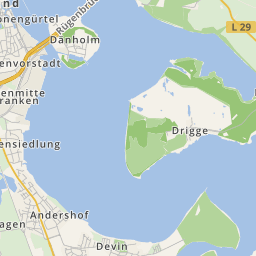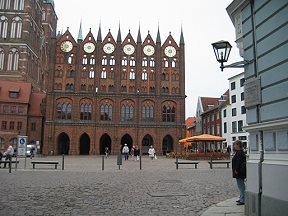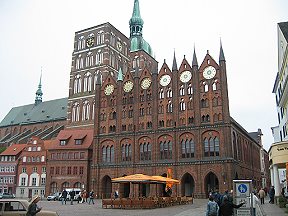












The town hall is one of the earliest solid constructions built in Stralsund. It was originally not only used to accommodate the council but also served as a "kophus" for trading purposes.
The "cellarium" was mentioned in 1278 as a special and a most important part of the building in the town hall. The cellars of the two "Längshäuser" are covered in cross arches. Even the passage between the present Badenstraße to the Alten Markt (old market) must have had a cellar underneath it since the 13th century.
It has not been possible to determine when the building works on the two Längshäusern with the trade rooms on the ground floor were completed. As there is evidence of a brisk business life in the "theatrum" after 1280, one can assume that these parts of the building were completed after the turn of the century. In the 14th century the northern porch on the market side was built and its ground floor, the "laube" was covered with two rows of cross arches. The main floor with its big hall was built on the same level as the top floors of the older Längshäuser. The saddle back roofs of the Längshäuser were built over the hall and the building in between was also given a saddle back roof. To make this group of buildings into one unit, a high wall was built, whose architectural figuration gives the town hall its representative appearance, following the example in Lübeck.

The house at no. 5 on the Alten Markt (old market), the "Wulflamhaus" is one of the most noteworthy Middle Age Gable Houses of the town. It was built in 1350 by the order of the men of the council at that time and the mayor Bertram Wulflam. He played a great role in the Hanseatic League. He represented the town during Hanseatic days, was involved in the realisation of the "Stralsund peace deal" of 1370 between the Hanseatic cities and Denmark and knew that he had to develop Stralsund town into a leading Hanseatic town. His house has in addition to an entrance hall, a gallery, a "kemladen" and a storage space, a 'hall floor', which punctuates the importance of his position as well as his craving for recognition. However Wulflam's autocratic management of the town's business matters, including the finances, aroused the people of Stralsunder indignation more and more. This lead to the 1391 reform of the town's constitution under Karsten Sarnow and the fall of Wulflam.
A favourite object of photography is the beautiful Gabel, whose original creation has a lot of similarity with the cladding of the town hall. After the completed reconstruction in 1991, the Wulflamhaus made an ideal attractive guest house and domicile of the trade department. The Wulflamhaus also has a brewery in the courtyard, which many years ago served as Stralsunder's main beer production. Today it is home to an interesting small site for the theatre and the Low German "Spädäl".